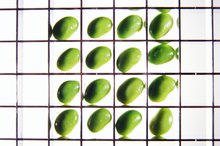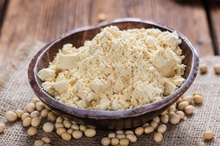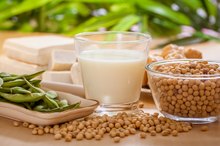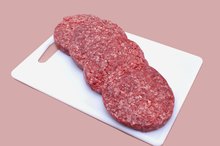Soy Protein & Male Breasts
Gynecomastia is the abnormally large growth of breast tissue in boys and adult men. Most often gynecomastia is associated with an imbalance between the hormones testosterone and estrogen. Soy contains a variety of chemicals, including phytoestrogens, or “plant estrogens.” The link between gynecomastia and soy proteins has yet to be fully established and the two cannot be linked without further human studies.
Phytoestrogens
Soy protein contains two hormone-like substances called genistein and daidzein, according to Dr. Miguel A. Delgado. These chemicals have a structure and function similar to the human hormone estrogen. When ingested in large quantities, these phytoestrogens cause your estrogen levels to rise. High estrogen levels may theoretically stimulate the production of breast tissue and lead to gynecomastia. However, there are no studies to demonstrate that soy has this effect on human tissue. More research is necessary to determine if soy increases your risk of gynecomastia.
Soy and Gynecomastia
Soy and Hormonal Imbalance
Learn More
An article in a 2008 issue of “Endocrine Practice” reported on a case in which the patient had developed gynecomastia due to the ingestion of soy products. This is an unusual and rare condition that occurred when the patient started drinking 3 quarts of soy milk per day. Once he stopped drinking the soy milk, there was a significant reduction in the size of his breast tissue. This study provides evidence that there may be a link between soy and gynecomastia, but the exact association will need further elucidation.
Evidence Against Soy Causing Gynecomastia
Elevations in the levels of genistein and daidzein do not correlate with an increased risk of gynecomastia. A study published in the January 2002 edition of the “American Journal of Clinical Nutrition" found that high levels of phytoestrogens did not cause gynecomastia or other estrogenic effects in healthy men. This indicates that either soy is not linked to gynecomastia or that there are other factors that play a role in soy-based gynecomastia.
Treatment for Gynecomastia
The Benefits and Drawbacks of Soy Protein Powder in Women
Learn More
Commonly, gynecomastia spontaneously resolves given enough time. However, if there is an underlying cause, such as hypogonadism, liver disease or malnutrition, then further treatment is often required. You may need to change your eating habits or undergo surgery. Corrective surgeries, like liposuction or mastectomies, may be necessary. Talk to your doctor about the potential treatment options available.
Related Articles
References
- National Institutes of Health: Gynecomastia
- Miguel A. Delgado, M.D.: Soy Milk Possible Cause of Gynecomastia, Enlarged Male Breasts
- Endocrine Practice; An Unusual Case of Gynecomastia Associated with Soy Product Consumption; J. Martinez and J.E. Lewi
- American Journal of Clinical Nutrition; Clinical Characteristics and Pharmacokinetics of Purified Soy Isoflavones: Single-dose Administration to Healthy Men; Marjorie G Busby et al.
Writer Bio
Joseph Pritchard graduated from Our Lady of Fatima Medical School with a medical degree. He has spent almost a decade studying humanity. Dr. Pritchard writes as a San Francisco biology expert for a prominent website and thoroughly enjoys sharing the knowledge he has accumulated.









